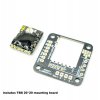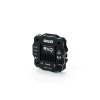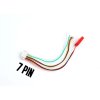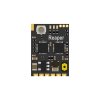Video Transmitters
Product sorting
Brands
List of products
Listing controls
Video transmitters, or VTx, operate similarly to radio technology. At its most basic level, your FPV flight camera connects to your video transmitter. The camera converts the images it captures into data, which is then sent to the video transmitter. The VTx transforms this data into a radio signal and transmits it through a connected antenna. This antenna then sends the signal out. A video receiver (VRx), connected either to your goggles or a ground station, receives this signal and converts it back from radio waves into data, which is then displayed on a screen.
The range of your VTx depends heavily on several factors: the power level of your VTx (rated in milliwatts or mW), the antenna connected to your VTx, the antenna attached to the video receiver, and the frequency band you are using (including potential signal interference).
VTx systems transmit your video feed over specific frequencies. Think of it like tuning a car radio to a specific station — you won’t receive that particular station until your radio is set to the correct frequency. The same applies to your VTx and VRx. Both must be set to the same channel for the most stable connection. When choosing a VTx, first select one that operates within the overall frequency spectrum you need. For most applications, a 5.8 GHz transmitter/receiver combination is sufficient.
VTx devices are further divided into bands and channels. Each band typically offers around 8 channels to choose from. Channels serve two main purposes: to select the least crowded channel to minimize interference at a given location and to separate pilots by at least 60 Hz when flying together to avoid signal interference. For example, if you’re using a frequency of 5800, other pilots should fly at 5740 or 5860 to ensure minimal overlap.
















